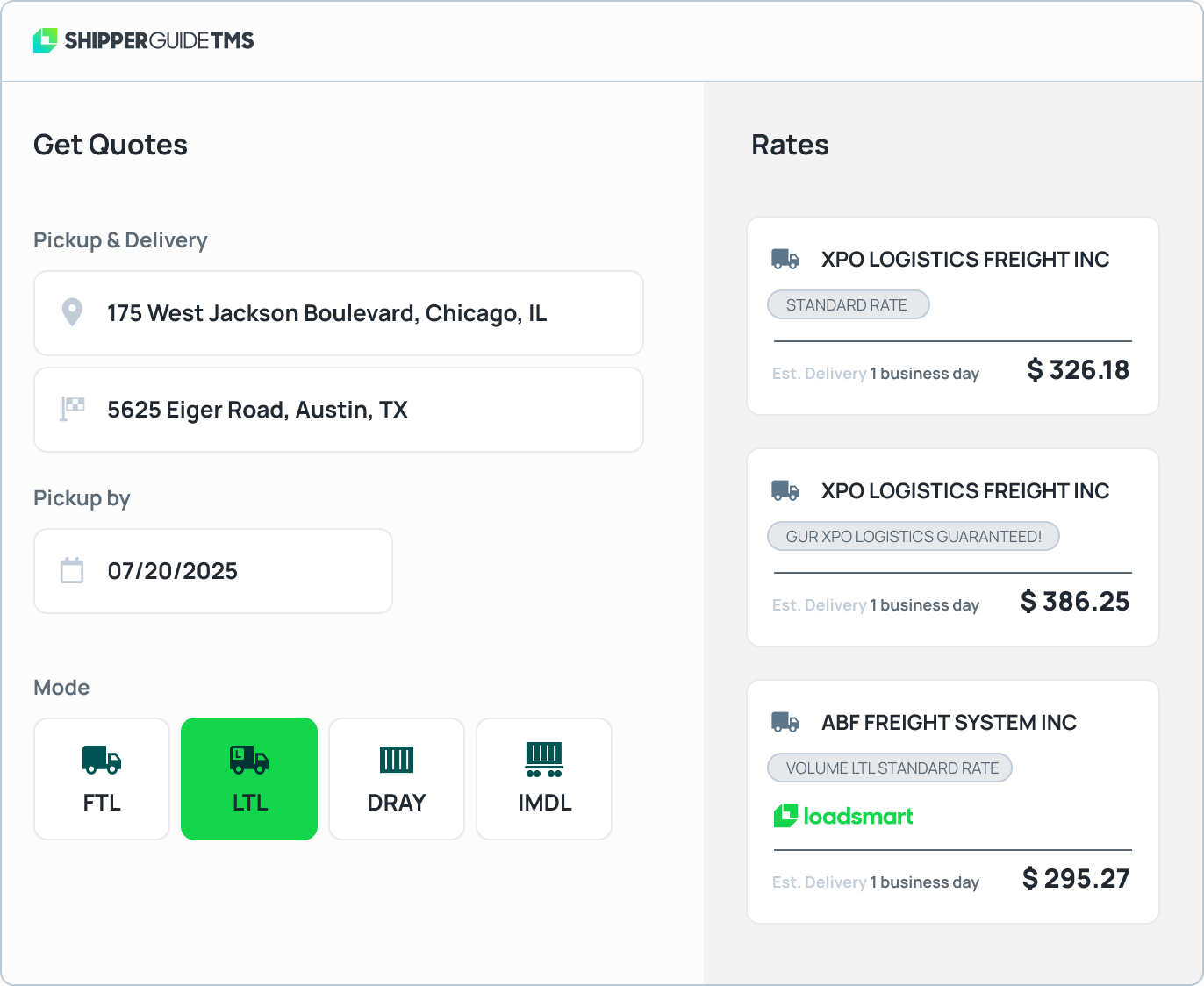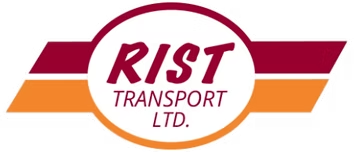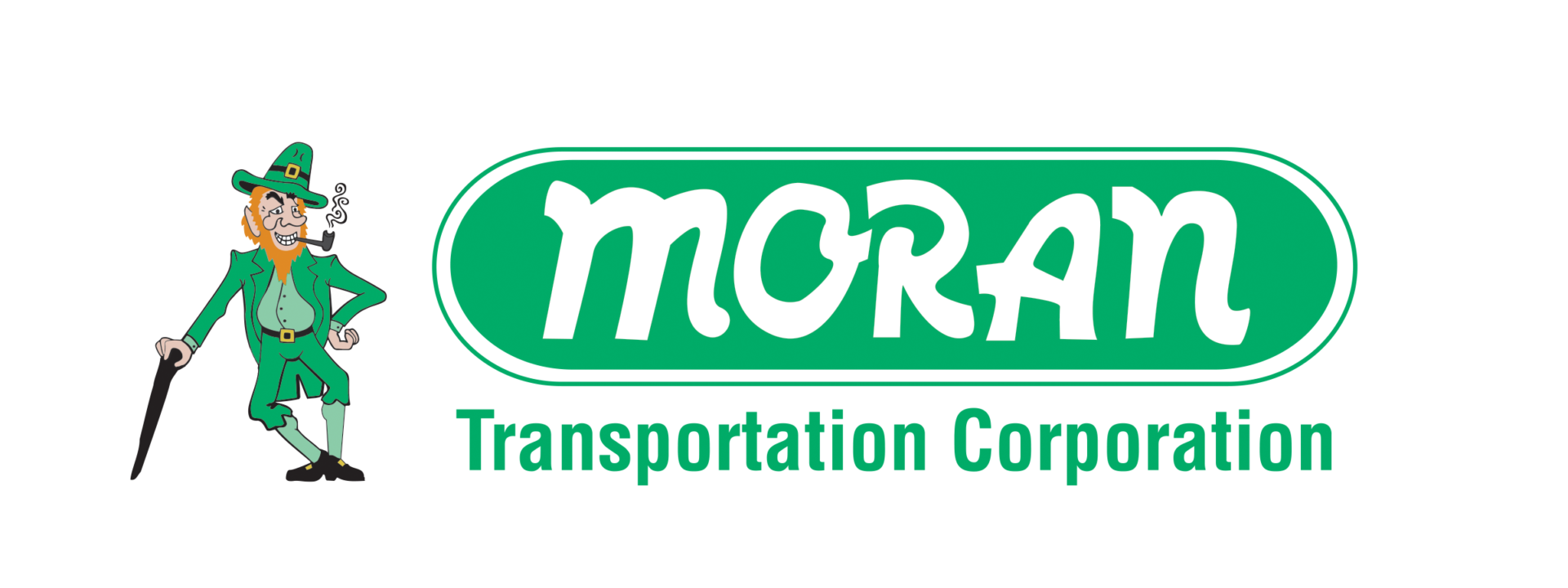LTL Shipping
Made Easy, Get an Instant Quote Now!
Standard LTL, Time-Critical LTL, Volume LTL, and Partial Truckload in one quote flow.
Get An Instant LTL Quote
Your Instant LTL Quote
Based on the details you entered, here's your estimated shipping cost
U$ 00.00
Want to lock in this rate?
- Rates are estimates based on haul and fuel costs typically quoted through Loadsmart when moving with a third-party carrier. Actual rates may vary.
- Estimates do not include additional charges such as accessorial fees, special handling, or surcharges.
- Rates reflect the cost of standard LTL service levels only. Enhanced services such as expedited, guaranteed delivery, or white-glove are not included.
"We’ve saved 17% on LTL freight so far this year!”
Eric Haywood
Logistics Supervisor, Red Gold

Balancing people and technology to take the guesswork out of LTL
Whether you want to quote & book online yourself or through your account manager, Loadsmart works to ensure you have control and visibility from quoting to settlement.
Accurately pricing LTL freight is frustrating. We balance software with our multimodal freight experts to ensure you’ll receive a variety of pricing options. Obtain accurate quotes in just a few simple clicks
Behind every shipment, there’s a team of logistics nerds ensuring your freight moves efficiently. Your dedicated account manager is your logistics veteran and data expert that's ready to strategize, problem-solve, and optimize your shipments based on your unique needs. Whether you're navigating complex freight classifications or optimizing for cost and speed, we geek out on logistics so you don’t have to.
You can get full visibility into your shipment status at the click of a button. With our free freight management platform, each LTL shipment has its automated tracking link, so you can have comfort in knowing where your shipment is in real time.
Whether your top priority is service, cost, or speed, our platform has technology designed to support the needs of your business. We offer Standard LTL, Volume LTL, and Partial Truckload (PTL) rates in a singular quote flow.
Loadsmart Offers LTL Shippers:
Personalized shipment
Personalized shipment options based on your priority, whether that is cost, transit time, or mode
Instantly Quote And Book LTL
The ability to instantly quote and book LTL shipments through our multimodal freight procurement software
Automated Tracking
Automated tracking on all your LTL shipments
25+ Reputable Providers
Shipping Labels Ready
Print Shipping labels straight from the platform
Customized Reporting
A Dedicated Account Manager
Freight Audit & Pay
Uncover hidden billing discrepancies, and ensure accurate LTL invoicing with Loadsmart’s seamless Freight Audit & Pay solutions
"We were sitting there thinking, ‘Are these savings real?’ And to our surprise, not only were they real, but they were better than what was actually proposed!"
Eric Haywood
Logistics Supervisor, Red Gold

Optimize LTL shipping operations with ShipperGuide, our next-generation Transportation Management System.
ShipperGuide LTL Platform provides a seamless experience through a direct connection to 25+ reputable carriers, integrated shipment management and tracking capabilities, and an AI based CoPilot tool to uncover dynamic insights on your supply chain.

Our LTL Partners
National Carriers









Regional Carriers







.png?width=142&height=50&name=Mountain%20Valley%20Express%20(GLS).png)








Multi-regional Carriers


Asset-light Carriers


Loadsmart LTL FAQs
- Greater schedule reliability and flexibility
- Least expensive of the options (cost of the truck is shared among multiple shippers, each shipper pays a lower rate than they would for FTL shipping)
- Cost effective for smaller shipments
- Reliable network of trusted common carriers
- More flexible than FTL
- Cost savings – Pay only for the space your freight occupies.
- Flexibility – Ideal for smaller shipments that don’t fill an entire truck.
- Tracking & Visibility – LTL carriers provide shipment tracking.
- Reduced Environmental Impact – Consolidating freight reduces the number of trucks on the road.
LTL freight classifications help determine shipping costs based on a shipment’s weight, density, value, and how it can be stacked or stored. The National Motor Freight Traffic Association (NMFTA) assigns these codes, ranging from Class 50 to Class 500. Generally, heavier and denser items have lower (and cheaper) classifications, while lighter, fragile, or bulky items fall into higher (and more expensive) classes. These standardized codes make it easier to compare quotes from carriers.
- National Motor Freight Classification (NMFC): The most widely used system, based on weight, density, value, and stowability. It's generally seen as a fair way to determine shipping costs.
- Dimensional Rating: This method uses the shipment's dimensions (length, width, height, and weight) to calculate costs. While accurate, it can be more expensive and isn't as widely accepted by businesses.
Freight class is determined by the NMFC (National Motor Freight Classification) system and is based on four key factors:
- Density (weight per cubic foot)
- Stowability (how easily it fits with other freight)
- Handling (ease or difficulty of moving it)
- Liability (value and risk of damage or theft)
You can quickly determine your class using our NMFC Class Lookup Tool or by reaching out to your account representative for help
LTL (Less Than Truckload) shipping is ideal for businesses that ship palletized freight that’s too big for parcel/small package but too small for full truckload—typically 1 to 6 pallets or up to around 15,000 lbs. Businesses across many industries can realize benefits associated with LTL shipping.
LTL offers cost savings, flexibility, and network reach for businesses that don’t need a full truck but still want reliable transit.
LTL rates are calculated by a variety of factors, including:
- Shipment weight, dimensions, & density
- Distance travelled between pickup and delivery
- Freight class (which is determined by factors like density, stowability, handling, and liability)
- Accessorial Charges (liftgate services, extra fees, delivery appointments)
- Seasonal fluctuations and market conditions
The main factors you should consider when choosing an LTL carrier depends on where you are located, where your freight is going, what your freight is, and service level, and pricing.
Geographic Coverage & Network Density: ensure the carrier has enough terminals, equipment, and service routes/lanes that cover your pickup/dropoff locations.
Service Performance & Reliability: look for carriers with a good record of on-time pickup/deliveries and lower claim rates, which indicates the carrier handles shipments with care.
Cost & Pricing: Carriers with clear, transparent, and competitive pricing while avoiding surcharges.
- Properly package and palletize shipments to avoid reclassification.
- Choose standard delivery instead of expedited options.
- Avoid accessorial charges by ensuring proper equipment is available at pickup/delivery.
- Plan ahead and ensure your freight is well packaged, weighed and measured - to avoid any unnecessary fees
- Use a freight brokerage or shipping platform to compare rates and optimize routes.
If your shipment is damaged or lost, you can file a claim with the carrier with Loadsmart guiding you through the entire process! Make sure to:
- Inspect the shipment upon arrival.
- Document any damages with photos.
- Note damages on the delivery receipt.
- Submit a claim with supporting documentation (BOL, photos, and invoice).
Transit times vary based on distance, carrier schedules, and weather conditions. Most LTL shipments are delivered within 2 to 7 business days, but expedited options are available